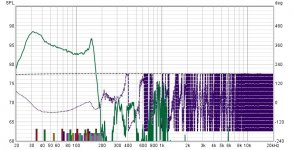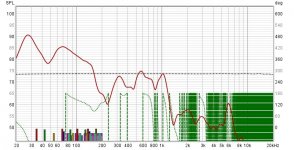I am wondering how to proceed to get the correct port measurement in a 2.5 way. Both upper and lower drivers are needed to simultaneously produce the correct tuning frequency, but when one driver is disconnected and I take a measurement on one driver only , I get a queer port bump as can be seen in the 2nd pic.
1st pic is the normal measurement with both drivers connected.
My aim is to get the correct measurements procedure in view to merge port and nearfield for merging in the first instance and then get the farfield and finalising them all into a quasi-anechoic FRD for xover purposes. Can anyone help? I did not find the solution on the forum.
1st pic is the normal measurement with both drivers connected.
My aim is to get the correct measurements procedure in view to merge port and nearfield for merging in the first instance and then get the farfield and finalising them all into a quasi-anechoic FRD for xover purposes. Can anyone help? I did not find the solution on the forum.
Attachments
When you measured the port response with only one driver driven, did you apply a short circuit across the terminals of the un-driven driver? If you did not, the un-driven driver will act as a passive radiator if both drivers share the same enclosure and may radically change the port response.
Peter
Peter
some clarifications: you mean I keep the other driver connected to + and - leads and apply a short cirtcuit between its terminals. Won' it cause a short-circuit to the amp output?
You could also use the "microphone in box" technique to get around the issue of merging the SPL curves. See here:
http://www.renatogiussani.it/pdf/Simplified-Loudspeaker-Measurements-at-Low-Frequencies.pdf
https://audioxpress.com/article/measuring-loudspeaker-low-frequency-response (scroll down about half way)
http://www.renatogiussani.it/pdf/Simplified-Loudspeaker-Measurements-at-Low-Frequencies.pdf
https://audioxpress.com/article/measuring-loudspeaker-low-frequency-response (scroll down about half way)

